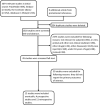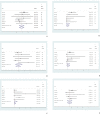Efficacy and Safety of Hypomethylating Agents in Chronic Myelomonocytic Leukemia: A Single-Arm Meta-analysis
- PMID: 35707788
- PMCID: PMC9192189
- DOI: 10.1055/s-0042-1744157
Efficacy and Safety of Hypomethylating Agents in Chronic Myelomonocytic Leukemia: A Single-Arm Meta-analysis
Abstract
Background Chronic myelomonocytic leukemia (CMML) is a myeloid neoplasm with features of the myelodysplastic syndromes (MDSs) and myeloproliferative neoplasm presenting with peripheral blood monocytosis and an inherent risk for transformation to acute myeloid leukemia, while the abnormal DNA methylation plays a critical role in the pathogenesis of MDS, which is a disease of disordered differentiation. Recently, with the rapid development of molecular biology, hypomethylating agents (HMAs) for the treatment of MDS has gradually become a research focus. The objective of this study was to evaluate the benefits and risks of HMAs for patients with CMML. Materials and Methods PubMed, Embase, the Cochrane Library, and three Chinese databases were searched for studies published before November 2020 that used HMAs in CMML. Results The pooled objective response rate (ORR), complete response (CR), and partial response (PR) were 50.0, 21.0, and 2.0%, respectively. The proportion of patients with minor response (MR) was significantly higher for decitabine (DAC) than for azacitidine (AZA). There was no significant difference in hematologic improvement, ORR, CR, and PR rates between the DAC and AZA groups. Hematological toxicity included neutropenia grade 3/4 (14.0%), anemia grade 3/4 (17.0%), and thrombocytopenia grade 3/4 (22.0%). Conclusion This study showed that HMAs were effective and safe in the treatment of CMML, but large multicenter study would be needed to confirm the efficacy of HMAs for the treatment of CMML with different risk level and genetic abnormality, to support individualization treatment theoretically.
Keywords: azacitidine; chronic myelomonocytic leukemia; decitabine; hypomethylating agents; meta-analysis; myelodysplastic syndromes; single-arm.
The Author(s). This is an open access article published by Thieme under the terms of the Creative Commons Attribution License, permitting unrestricted use, distribution, and reproduction so long as the original work is properly cited. ( https://creativecommons.org/licenses/by/4.0/ ).
Conflict of interest statement
Conflict of Interest None declared.
Figures





Similar articles
-
Hypomethylating agents in the treatment of chronic myelomonocytic leukemia: a meta-analysis and systematic review.Hematology. 2021 Dec;26(1):312-320. doi: 10.1080/16078454.2021.1875600. Hematology. 2021. PMID: 33706667
-
An unusual response to 5-azacitidine by a patient with chronic myelomonocytic leukemia.Clin Case Rep. 2023 Aug 2;11(8):e7748. doi: 10.1002/ccr3.7748. eCollection 2023 Aug. Clin Case Rep. 2023. PMID: 37546162 Free PMC article.
-
A systematic review and meta-analysis of the efficacy and adverse events of azacitidine-plus-lenalidomide treatment for patients with acute myeloid leukemia, myelodysplastic syndromes and chronic myelomonocytic leukemia 1.Hematology. 2019 Dec;24(1):498-506. doi: 10.1080/16078454.2019.1631425. Hematology. 2019. PMID: 31221030
-
Comparison Between Decitabine and Azacitidine for Patients With Acute Myeloid Leukemia and Higher-Risk Myelodysplastic Syndrome: A Systematic Review and Network Meta-Analysis.Front Pharmacol. 2021 Aug 17;12:701690. doi: 10.3389/fphar.2021.701690. eCollection 2021. Front Pharmacol. 2021. PMID: 34483903 Free PMC article.
-
Comparison of Azacitidine and Decitabine in Myelodysplastic Syndromes and Acute Myeloid Leukemia: A Network Meta-analysis.Clin Lymphoma Myeloma Leuk. 2021 Jun;21(6):e530-e544. doi: 10.1016/j.clml.2021.01.024. Epub 2021 Feb 24. Clin Lymphoma Myeloma Leuk. 2021. PMID: 33716056
References
-
- Itzykson R, Fenaux P, Solary E. Chronic myelomonocytic leukemia: myelodysplastic or myeloproliferative? Best Pract Res Clin Haematol. 2013;26(04):387–400. - PubMed
-
- Arber D A, Orazi A, Hasserjian R. The 2016 revision to the World Health Organization classification of myeloid neoplasms and acute leukemia. Blood. 2016;127(20):2391–2405. - PubMed
-
- Elliott M A, Tefferi A, Hogan W J. Allogeneic stem cell transplantation and donor lymphocyte infusions for chronic myelomonocytic leukemia. Bone Marrow Transplant. 2006;37(11):1003–1008. - PubMed
-
- Park S, Labopin M, Yakoub-Agha I. Allogeneic stem cell transplantation for chronic myelomonocytic leukemia: a report from the Societe Francaise de Greffe de Moelle et de Therapie Cellulaire. Eur J Haematol. 2013;90(05):355–364. - PubMed
LinkOut - more resources
Full Text Sources
Research Materials
Miscellaneous
